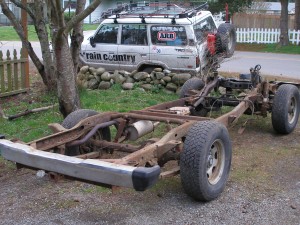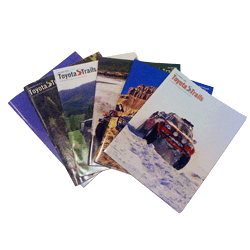–Engines–
2F
4.2L inline 6 cylinder gas
165 HP at 3600 rpm
210 Ft lbs of torque at 1800 rpm
3FE
4.0L EFI in line 6 cylinder gas, (sold in Japan with a carb as the 3F)
155 HP at 4000 rpm
220 ft lbs of torque at 3000 rpm
3B
3.4L in line 4 cylinder diesel, indirect injection (pre-combustion design)
98 HP at 3500 rpm
159 ft lbs of torque at 2200 rpm
2H
3.9L Inline 6 cylinder diesel, indirect injection
103 HP at 3500 rpm
177 ft lbs of torque at 2000rpm
12H-T
3.9L Inline 6 cylinder diesel with a turbo charger, direct injection
135 HP at 3400rpm
231 ft lbs of torque at 2000 rpm
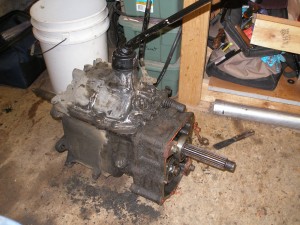 -Tranny options-
-Tranny options-
Several Transmissions were available in 60 series wagons. What follows is a brief description of each as well as the ratio’s found inside them. This was compiled from numerous resources so if you find a mistake please let me know.
Most of the trannys were essentially the same when it came to what engine they were installed behind with the exception of the models attached to 3B’s. The 3B version used a different input shaft to the engine, it has a 21 spline input shaft and a smaller diameter pilot on the end of the shaft compared to the 10 spline version for gas engines and the H series diesels. The input shaft on the 3B versions is longer as well.
–H42–
By and large the most common tranny found on US rigs, from 80 to 87. Was installed in two versions, short and what many call the long case model with the spacer. The spacer model appeared in april of 85 in the US, possibly earlier overseas. This tranny has the best road manners of all the manuals that were available.
1st 3.555
2nd 2.292
3rd 1.41
4th 1
Rev 4.271
-H41-
Not as common as the H42 and has very different ratio’s. No external markings to differentiante it from the H42, only easy way to tell them apart is to put them into first gear and count how many times the intput shaft goes around while you turn the ouput shaft, H41 should go around more than four times while the H42 will spin less than four for every revolution of the output shaft.
Essentially it has the same ratio’s as the H55 just minus 5th gear. Not sure if it was sold in a long case version or not. Great tranny to swap in for off road use do to the low first gear and are way cheaper than the H55, especially if you don’t want to do a gear swap. Unfortunately not the best road manners due to what many call gaps in the ratio’s. Most noticeable when mounted behind a 3B
1st 4.843
2nd 2.618
3rd 1.516
4th 1
Rev 4.843
–H55–
What many consider the ultimate Landcruiser tranny, why it was never sold in the US still boggles my mind. All the same gearing as an H41 with the addition of an overdrive 5th gear. Only available in a long case version, mainly due to the fact 5th gear resides on the back side of the main gearbox and is concealed in the spacer. Pretty ingenious of Toyota to come up with this. Two trannys, same gearbox casting. Even the shift mechanism is somewhat of an add on as it’s external in relation to the other gears, comes out the top cover and hooks to the linkage in the spacer. For obvious reasons the same less than stellar road manners behind a 3B.
1st 4.843
2nd 2.618
3rd 1.516
4th 1
5th 0.845
R 4.843
–A440–
The automatic tranny was installed in 62’s from 88 to 90. It also appeared in HJ 60’s as early as 1984. Treated properly and these are good trannys. If you run large tires it is advisable to change the gears in the diff. Being an auto it is sensitive to tire speed and engine RPM. Larger tires tend to confuse these trannys and will shorten the life of them. And due to how differently an auto operates you can’t really compare the ratios listed to a manual tranny.
1st 2.95
2nd 1.53
3rd 1
4th 0.717
Rev 2.678
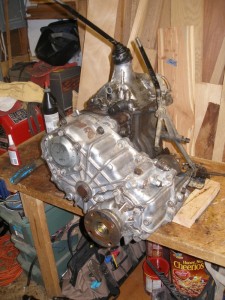 –Transfer Cases–
–Transfer Cases–
Several t-cases were used in our wagons but primarily an early and late version. And unlike the 3B specific trannys the t-cases don’t care what is on the front side of the tranny, they fit diesel and gas rigs. And you will find variations on these t-cases as well, such as the 1.963 low range model that was fitted to Australian 60’s with the 5 speeds, these were in the diesel and the petrol models. The t-cases used in our 60’s all required a 19 spline output shaft on the tranny.
-Early version-
This was used on trannys without the spacer. Was fitted in 80-82 models in the US. This t-case has the 34mm idler shaft. Another version of this case was then fitted to 83-84 models. This one included an additional spacer and machine work on the front half of the housing as it was also used on the newer spacer style tranny’s including 5 speeds in other countries. And even though it was attached to newer trannies it still has a 34mm idler.
High range was 1 to 1
Low range was 2.276
-Late Model-
An increase in size of the idler shaft to 38mm. This model was fitted from 85-87. And also fitted to FJ62’s, 88-90, with the addition of a vacuum shift for in and out of 4WD, low range was still engaged manually. Other markets, including Canada, even had vacuum shifted t-cases coupled to manual tranny’s. And even though the t-cases off the manual trannies are almost identical to the ones for the auto, there is some additional machine work inside the vacuum controlled t-case that provides lube to the vacuum shift mechanism. Keep this in mind if you need to replace a vacuum shift t-case and want to maintain the vacuum controls.
High range was 1 to 1
Low range was 2.276 from 85-87
Low range was 2.296 from 88-90 on the FJ62’s
(Ausralian 5 speeds got a low range of 1.963 88-90)
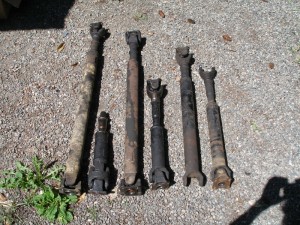 –Driveshafts–
–Driveshafts–
There were 3 different sets of driveshafts installed in 60’s. The picture shows the differences between the years with the earliest on the left.
Thown into this mix was also two different flange patterns. Early rigs had a more square flange with a rectangular bolt pattern and the newer or late versions went to a more square bolt pattern with a round flange plate. Its easy to swap ends on the driveshafts if needed as the same u-joint appeared on all years of the wagons. Just match the pattern on your diff flanges and you are good to go.
80-84 Used a short front shaft with a double carden joint at the tcase. Rear shaft was quite long
85-87 Middle of the road. Front shaft got a little longer, approx 3.5 in, with the appearance of spacers on the 4 speed here in the US but may have appeared sooner in other markets when 5 speeds first appeared (Canada got the 5 speeds in 83). 5 speeds use the same shaft as the spacer/long case version of the 4 speed.
88-90 The front shaft was again lengthened to accommodate the added length of the A440. Rear shaft got shortened by the same amount.

